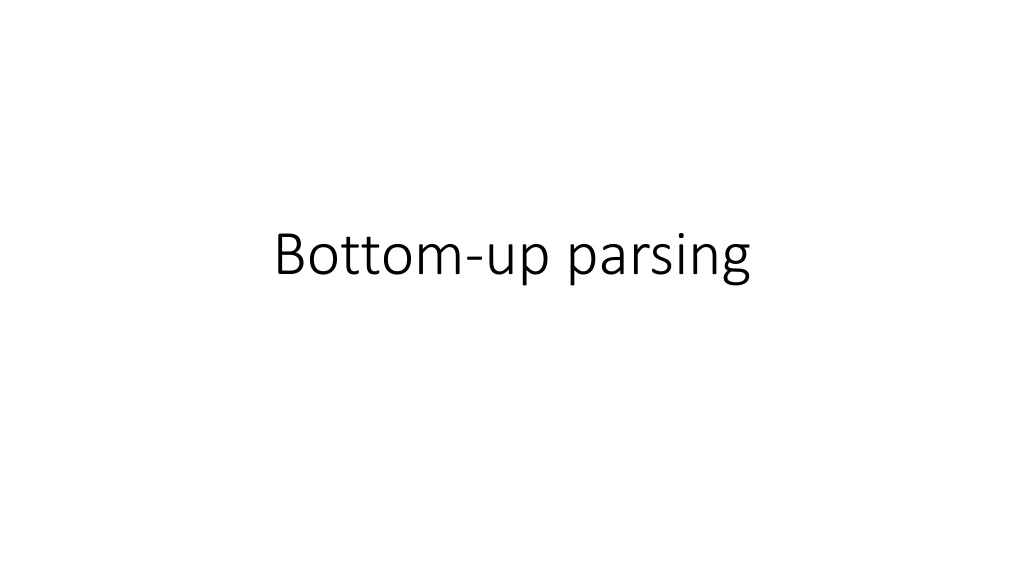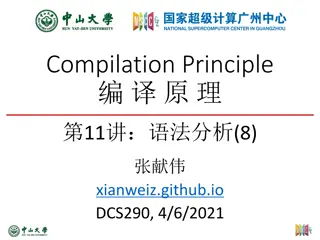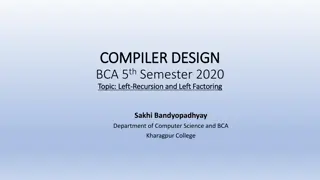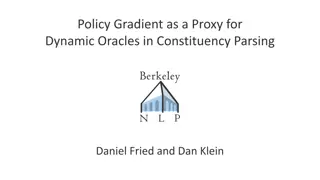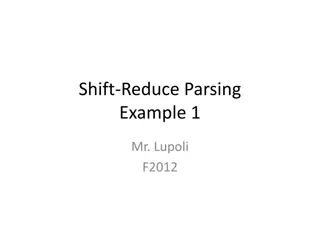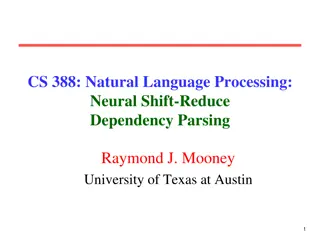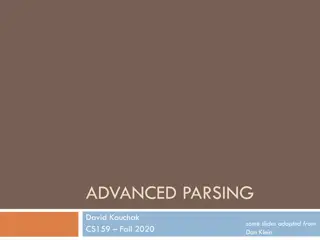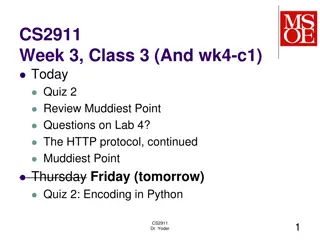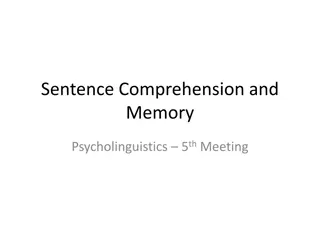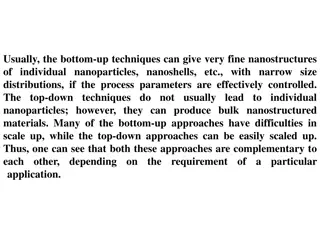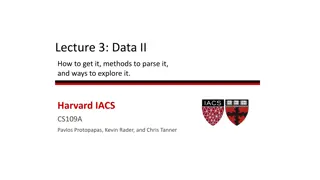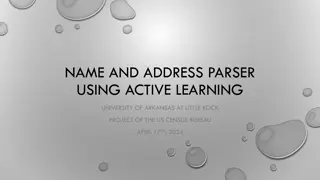Understanding Bottom-Up and Top-Down Parsing in Computer Science
Bottom-up parsing and top-down parsing are two essential strategies in computer science for analyzing and processing programming languages. Bottom-up parsing involves constructing a parse tree starting from the leaves and moving towards the root, while top-down parsing begins at the root and grows towards the leaves. Both methods involve selecting productions and matching input strings, with bottom-up parsing focusing on reduction steps to build the parse tree. Unambiguous grammars are key to successful parsing, enabling the identification of unique handles for derivation.
Download Presentation

Please find below an Image/Link to download the presentation.
The content on the website is provided AS IS for your information and personal use only. It may not be sold, licensed, or shared on other websites without obtaining consent from the author. Download presentation by click this link. If you encounter any issues during the download, it is possible that the publisher has removed the file from their server.
E N D
Presentation Transcript
Top-Down Parsing: Start at the root of the tree and grow towards leaves. Pick a production and try to match the input. We may need to backtrack if a bad choice is made. Some grammars are backtrack-free (predictive parsing).
Bottom-Up Parsing Goal: Given a grammar, G, construct a parse tree for a string (i.e., sentence) by starting at the leaves and working to the root (i.e., by working from the input sentence back toward the start symbol S). Recall: the point of parsing is to construct a derivation: S 0 1 2 ... n-1 sentence To derive i-1from i, we match some rhs b in i, then replace b with its corresponding lhs, A. This is called a reduction (it assumes A b). The parse tree is the result of the tokens and the reductions.
Example Example: Consider the grammar below and the input string abbcde. 1. Goal aABe 2. A Abc 3. |b 4. B d Sentential Form abbcde a A bcde a A de a A B e Goal Production 3 2 4 1 - Position 2 4 3 4 -
Example Example: Consider the grammar below and the input string abbcbcde. 1. Goal aABe 2. A Abc 3. |b 4. B d Sentential Form Production Position
Input string: abcde Sentential Form Production Position 1. Goal 2. A 3. 4. 5. B 6. ABB Abc |b |a d |e
Finding Reductions What are we trying to find? A substring b that matches the right-side of a production that occurs as one step in the rightmost derivation. Informally, this substring is called a handle. Formally, a handle of a right-sentential form is a pair <A b,k> where A b P and k is the position in of b s rightmost symbol. (right-sentential form: a sentential form that occurs in some rightmost derivation). Because is a right-sentential form, the substring to the right of a handle contains only terminal symbols. Therefore, the parser doesn t need to scan past the handle. If a grammar is unambiguous, then every right-sentential form has a unique handle (sketch of proof by definition: if unambiguous then rightmost derivation is unique; then there is unique production at each step to produce a sentential form; then there is a unique position at which the rule is applied; hence, unique handle). If we can find those handles, we can build a derivation!
Motivating Example Given the grammar of the left-hand side below, find a rightmost derivation for x 2*y (starting from Goal there is only one, the grammar is not ambiguous!). In each step, identify the handle. 1. Goal Expr 2. Expr Expr + Term 3. | Expr Term 4. | Term 5. Term Term * Factor 6. | Term / Factor 7. | Factor 8. Factor number 9. | id Production Sentential Form - Goal 1 Expr 3 Expr Term Handle - 1,1 3,3 Problem: given the sentence x 2*y, find the handles! 7-Oct-24 COMP36512 Lecture 9 8
A basic bottom-up parser The process of discovering a handle is called handle pruning. To construct a rightmost derivation, apply the simple algorithm: fori=n to 1, step -1 find the handle <A b,k>i in i replaceb with A to generate i-1 (needs 2n steps, where n is the length of the derivation) One implementation is based on using a stack to hold grammar symbols and an input buffer to hold the string to be parsed. Four operations apply: shift: next input is shifted (pushed) onto the top of the stack reduce: right-end of the handle is on the top of the stack; locate left-end of the handle within the stack; pop handle off stack and push appropriate non-terminal left-hand-side symbol. accept: terminate parsing and signal success. error: call an error recovery routine. 7-Oct-24 COMP36512 Lecture 9 9
Example: x2*y Stack Input Handle None 9,1 7,1 4,1 None None 8,3 7,3 None None 9,5 5,5 3,3 1,1 none Action Shift Reduce 9 Reduce 7 Reduce 4 Shift Shift Reduce 8 Reduce 7 Shift Shift Reduce 9 Reduce 5 Reduce 3 Reduce 1 Accept $ $ id $ Factor $ Term $ Expr $ Expr $ Expr num $ Expr Factor $ Expr Term $ Expr Term * $ Expr Term * id $ Expr Term * Factor $ Expr Term $ Expr $ Goal id num * id num * id num * id num * id num * id num * id !! * id * id * id id !! 1. Shift until top of stack is the right end of the handle 2. Find the left end of the handle and reduce (5 shifts, 9 reduces, 1 accept) 7-Oct-24 COMP36512 Lecture 9 10
Example: x/4+2*y Input Handle Action Stack $ COMP36512 Lecture 9 7-Oct-24 11
What can go wrong? (think about the steps with an exclamation mark in the previous slide) Shift/reduce conflicts: the parser cannot decide whether to shift or to reduce. Example: the dangling-else grammar; usually due to ambiguous grammars. Solution: a) modify the grammar; b) resolve in favour of a shift. Reduce/reduce conflicts: the parser cannot decide which of several reductions to make. Example: id(id,id); reduction is dependent on whether the first id refers to array or function. May be difficult to tackle. Key to efficient bottom-up parsing: the handle-finding mechanism.
LR(1) grammars (a beautiful example of applying theory to solve a complex problem in practice) A grammar is LR(1) if, given a rightmost derivation, we can: (I) isolate the handle of each right-sentential form, and (II) determine the production by which to reduce, by scanning the sentential form from left-to-right, going at most 1 symbol beyond the right-end of the handle.
LR(1) grammars LR(1) grammars are widely used to construct (automatically) efficient and flexible parsers: Virtually all context-free programming language constructs can be expressed in an LR(1) form. LR grammars are the most general grammars parsable by a non-backtracking, shift-reduce parser (deterministic CFGs). Parsers can be implemented in time proportional to tokens+reductions. LR parsers detect an error as soon as possible in a left-to-right scan of the input. L stands for left-to-right scanning of the input; R for constructing a rightmost derivation in reverse; 1 for the number of input symbols for lookahead.
LR Parsing: Background Read tokens from an input buffer (same as with shift- reduce parsers) Add an extra state information after each symbol in the stack. The state summarises the information contained in the stack below it. The stack would look like: $ S0 Expr S1 - S2 num S3
LR Parsing: Background Use a table that consists of two parts: action[state_on_top_of_stack, input_symbol]: returns one of: shift s (push a symbol and a state); reduce by a rule; accept; error. goto[state_on_top_of_stack,non_terminal_symbol]: returns a new state to push onto the stack after a reduction.
The Big Picture: Prelude to what follows LR(1) parsers are table-driven, shift-reduce parsers that use a limited right context for handle recognition. They can be built by hand; perfect to automate too! Summary: Bottom-up parsing is more powerful! source code I.R. Table-driven Parser Scanner tokens The table encodes grammatical knowledge It is used to determine the shift-reduce parsing decision. grammar Parser Generator Table 17
Example Consider the following grammar and tables: 1. Goal CatNoise 2. CatNoise CatNoise miau 3. | miau ACTION eof - accept Reduce 3 Reduce 2 GOTO CatNoise 1 STATE miau Shift 2 Shift 3 Reduce 3 Reduce 2 0 1 2 3 Example 1: (input string miau) Stack Input $ s0 miau eof $ s0 miau s2 eof $ s0 CatNoise s1 eof Note that there cannot be a syntax error with CatNoise, because it has only 1 terminal symbol. miau woof is a lexical problem, not a syntax error! Action Shift 2 Reduce 3 Accept Example 2: (input string miau miau) Stack $ s0 $ s0 miau s2 $ s0 CatNoise s1 $ s0 CatNoise s1 miau s3 eof $ s0 CatNoise s1 Input miau miau eof miau eof miau eof Action Shift 2 Reduce 3 Shift 3 Reduce 2 accept eof is a convention for end-of-file (=end of input) eof 18
Example: the expression grammar 1. Goal s0Expr s1 2. Expr s0Expr s1+ s6Term s10 3. | s0Expr s1 s7Term s11 4. 5. Term s0Term s2 * s8Factor s12 | s0Term s2 6. | s0Term s2 / s9Factor s13 7. 8. Factor s0number s4 | s0Factor s3 9. | s0id s5 19
Example: the expression grammar ACTION * GOTO STA TE 0 1 2 3 4 5 6 7 8 9 10 11 12 13 1. Goal Expr 2. Expr Expr + Term eof + / num id Expr Term Factor S 4 S 4 S 4 S 4 S 4 S 5 S 5 S 5 S 5 S 5 1 2 10 11 3 3 3 12 13 Acc R 4 R 7 R 8 R 9 R 2 R 3 R 5 R 6 S 6 R 4 R 7 R 8 R 9 R 2 R 3 R 5 R 6 S 7 R 4 R 7 R 8 R 9 R 2 R 3 R 5 R 6 3. | Expr Term S 8 S 9 R 7 R 7 R 8 R 8 R 9 R 9 S 8 S 9 S 8 S 9 R 5 R 5 R 6 R 6 4. 5. Term Term * Factor | Term 6. | Term / Factor 7. 8. Factor number | Factor 9. | id Parse: a) X+2*Y b)X/4 Y*5 20
ACTION * GOTO STA TE 0 1 2 3 4 5 6 7 8 9 10 11 12 13 eof + / num id Expr Term Factor S 4 S 4 S 4 S 4 S 4 S 5 S 5 S 5 S 5 S 5 1 2 10 11 3 3 3 12 13 Acc R 4 R 7 R 8 R 9 R 2 R 3 R 5 R 6 S 6 R 4 R 7 R 8 R 9 R 2 R 3 R 5 R 6 S 7 R 4 R 7 R 8 R 9 R 2 R 3 R 5 R 6 S 8 R 7 R 7 R 8 R 8 R 9 R 9 S 8 S 8 R 5 R 5 R 6 R 6 S 9 S 9 S 9 21
ACTION * GOTO Stack Input Action STA TE 0 1 2 3 4 5 6 7 8 9 10 11 12 13 eof Acc R 4 R 7 R 8 R 9 R 2 R 3 R 5 R 6 + / num S 4 S 4 S 4 S 4 S 4 id S 5 S 5 S 5 S 5 S 5 Expr Term Factor 1 2 10 11 3 3 3 12 13 $s0 X/4-Y*5 S5 S 6 R 4 R 7 R 8 R 9 R 2 R 3 R 5 R 6 S 7 R 4 R 7 R 8 R 9 R 2 R 3 R 5 R 6 S 8 R 7 R 7 R 8 R 8 R 9 R 9 S 8 S 8 R 5 R 5 R 6 R 6 S 9 $s0Xs5 /4-Y*5 R9 $s0FactorS3 /4-Y*5 R7 $s0TermS2 /4-Y*5 S9 $S0TermS2/S9 4-Y*5 S4 S 9 S 9 $S0TermS2/S94S4 -Y*5 R8 $S0TermS2/S9FactorS13 -Y*5 R6 $S0TermS2 -Y*5 R4 $S0ExprS1 -Y*5 S7 $S0ExprS1-S7 Y*5 S5 $S0ExprS1-S7YS5 *5 R9 $S0ExprS1-S7FactorS3 *5 R7 $S0ExprS1-S7TermS2 *5 S8 $S0ExprS1-S7TermS2*S8 5 S4 $S0ExprS1-S7TermS2*S85S4 Eof R8 $S0ExprS1-S7TermS2*S8FactorS12 Eof R5 $S0ExprS1-S7TermS11 Eof R3 $S0ExprS1 Eof Acc 22
Example: STA TE 0 1 2 3 4 5 6 7 8 ACTION - S 5 R 5 S 6 R 6 R 6 R 4 GOTO id S 4 S 4 S 4 * eof Expr Term Factor 1 2 7 2 8 3 3 3 Accept R 3 R 5 R 6 R 2 R 4 23
X Y *5 24
X - Y /5 25
Example : LR(1) Table Generation STA TE ACTION GOTO 27
Summary Top-Down Recursive Descent: Pros: Fast, Good locality, Simple, good error-handling. Cons: Hand-coded, high-maintenance. LR(1): Pros: Fast, deterministic languages, automatable. Cons: large working sets, poor error messages. What is left to study? Checking for context-sensitive properties Laying out the abstractions for programs & procedures. Generating code for the target machine. Generating good code for the target machine. 29
